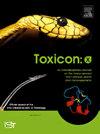雪上加霜的是:中毒后感染的回顾
IF 2.8
Q2 TOXICOLOGY
引用次数: 0
摘要
超过100种动物进化出了用于各种各样目的的毒液。据估计,有250万人被蛇咬伤,另有120万人被蝎子螫伤,其中许多中毒导致死亡。然而,生存并不是环境综合征的终点,因为慢性生活改变的条件,如截肢,毁容和神经病变可能发生。在这种情况下,中毒部位的感染可能发挥重要作用,因为它们可以加剧死亡率以及改变生命条件的发病率和严重程度。这篇综述评估了感染与感染之间的联系。它总结并强调了文献描述的情况下,毒液介导的感染由各种分类群和这些毒液的情况和感染的结果。由此可以推断,中毒导致感染的危险因素是多因素的。增加感染风险的因素包括:1. 使用更大的装置的输送系统会导致更严重的伤口;2 .毒液成分,含有细胞毒素的毒液通常与感染有关;环境,以水生微生物群和毒液系统微生物群为病原体物种的来源。感染很难诊断,因为感染的症状与感染的症状相同,建议医生在治疗的所有阶段都考虑感染的可能性。在我们对中毒导致的感染的理解上有一个显著的差距,进一步的研究将有助于提高患者的生存率。本文章由计算机程序翻译,如有差异,请以英文原文为准。

Adding insult to injury: A review of infections following envenomings
Over 100 lineages of animal have evolved venom for a wide variety of purposes. An estimated 2.5 million people are bitten by snakes and another 1.2 million are stung by scorpions with many envenomings resulting in death. However, survival is not the end point of the envenoming syndrome as chronic life altering conditions, such as amputations, disfigurement and neuropathies can occur. In this context, infections at the site of envenomation could play an important role as they can exacerbate mortality and the incidence and severity of life altering conditions.
This review assesses the connection between envenoming and infections. It summarises and highlights the literature describing cases of envenoming-mediated infection by various taxa and the circumstances of these envenomings and the outcomes of infection. It could be deduced that the risk factors for envenoming-led infections are multifactorial. Factors enhancing the risk of infection include; 1. The delivery system, with larger devices leading to more substantial wounds, 2. Venom composition, with venoms containing cytotoxins more commonly implicated in infections, and 3. The environment, with aquatic microbiomes and venom system microbiomes as sources of the pathogen species. Infections are difficult to diagnose due to symptoms synonymous with those of the envenoming and it is recommended that medical practitioners consider the possibility of infection throughout all stages of medical treatment. There is a notable gap in our understanding of envenoming-led infections and further research will help to increase patient survival.
求助全文
通过发布文献求助,成功后即可免费获取论文全文。
去求助
来源期刊

Toxicon: X
Pharmacology, Toxicology and Pharmaceutics-Toxicology
CiteScore
6.50
自引率
0.00%
发文量
33
审稿时长
14 weeks
 求助内容:
求助内容: 应助结果提醒方式:
应助结果提醒方式:


